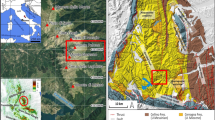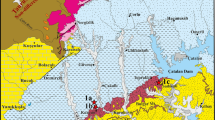Abstract
Outcrop-based sequence stratigraphic analysis and palynological biofacies were used to define depositional sequences and their bounding surfaces, and build a sequence stratigraphic model for the Upper Cretaceous succession of the Afikpo Sub-basin. Four unconformity-bounded third-order depositional sequences were identified. Sequence 1 comprises the Nkporo Formation and is subdivided into lowstand system tract (LST) representing an incised valley fill and transgressive systems tract (TST) consisting of estuarine and marine shales and mudstones. The base of the sequence is an angular unconformity correlated to the 77.5 Ma sequence boundary (SB) and the maximum flooding surface (MFS) is dated at 76 Ma. Sequence 2 is diachronous and straddles the lithostratigraphic boundary of the Nkporo and Mamu formations. The upper SB is dated at 71 Ma while associated MFS is dated at 73.5 Ma. Sequence 3 consists of the upper Mamu Formation and the Ajali Formation. The upper SB of sequence 3 is at 68 Ma while the MFS is dated at 69.8 Ma. Sequence 4 is the topmost depositional sequence belonging to the Nsukka Formation. The upper SB is placed at 66.5 Ma. The MFS within this sequence is dated at 67.8 Ma. The sequences encompass from tidally influenced bay head delta and central estuarine environments to coastal and shallow marine shelf environments. Stratigraphic architecture and facies types show that sequence development was controlled to a great extent by eustatic sea level variations though differential subsidence rates encouraged differential rates of sediment supply and rates of sea level change along different segments of the shoreline.














Similar content being viewed by others
References
Allen GP (1991) Sedimentary processes and facies in the Gironde estuary: a recent model for macrotidal estuary system. In: Smith DG, Reinson GE, Zaitlin BA, Rahmani R (Eds.), Clastic tidal sedimentology. Canadian Society of Petroleum Geologists. Memoir 16:25–36
Allen GP (1997) Sequence stratigraphy; practical guidelines. Principles and applications of sequence stratigraphy course notes 3: 53–57
Allen PA, Allen JRL (2005) Basin analysis. Principles and applications. Blackwell Scientific Publications, Oxford, London
Avbovbo AA, Ayoola EO (1981) Petroleum prospects of Anambra Basin, Southern Nigeria. Am Assoc Pet Geol Bull 64:66–672
Banerjee I, Kidall SM (1991) Significance of molluscan shell beds in sequence stratigraphy. An example from the lower Cretaceous Manville Group, Canada. Sedimentology 38:913–934
Benkhelil J (1982) Benue Trough and Benue Chain. Geol Mag 119:155–168
Benkhelil J (1987) Structural frame and deformations in the Benue Trough of Nigeria. Bull Centres Rech Explor-prod Elf-Aquitaine 11:160–161
Catuneanu O (2006) Principles of sequence stratigraphy. Elsevier BV, Amsterdam, Netherlands, p 375
Clifton HE (1982) Estuarine deposits. In Scholle PA, Spearing D. (Eds.) Sandstone depositional environments. American Association of Petroleum Geologists Memoir 6: 179–188
Dalrymple RW (1992) Tidal depositional systems. In: Walker RG and James NP (Eds.), Facies models: response to sea level change. Geological Association of Canada, 195–218
Edet JJ, Nyong EE (1994) Palynostratigraphy of Nkporo Shale exposures (Late Campanian-Maastrichtian) on the Calabar Flank, S.E Nigeria. Rev Palaeobot Palynol 8:131–147
Elliot T (1988) Siliciclastic shorelines. In: Reading HG (ed) Sedimentary environments and facies. Blackwell Science Publications Limited, Osney Mead, Oxford, pp 155–188
Genik GJ (1993) Petroleum geology of Cretaceous–Tertiary basins in Niger, Chad and Central African Republic. Am Assoc Pet Geol Bull 77:1405–1434
Germeraad JH, Hop** CA, Muller J (1968) Palynology of Tertiary sediments tropical areas. Rev Palaeobot Palynol 6:89–348
Hallam A, Bradshaw MJ (1979) Bituminous shales and oolitic ironstones as indicators of transgressions and regressions. J Geol Soc Lond 136:157–164
Haq BU, Hardenbol J, Vail PR (1987) Chronology of fluctuating sea levels since the Triassic. Science 235:1156–1166
Holz M, Simoes MG (2005) Taphonomy—overview of main concepts and applications to sequence stratigraphic analysis. In: Koutsoukos EAM (ed) Applied stratigraphy. Springer, Netherlands, pp 249–278
Hoque M (1977) Petrographic differentiation of tectonically controlled Cretaceous sedimentary cycles, southeastern, Nigeria. Journal of. Sediment Geol 17:235–345
Jain KP, Millipied P (1973) Cretaceous microplankton from Senegal Basin, NW Africa. Some new genera and combinations of dinoflagellates. Paleobotanist 20:22–32
Jan Du Chene RE (1978) Some new pollen species of the upper Maastrichtian, Tar Sand, Abeokuta formation, southern Nigeria. Revista Espanola De Micropaleontologia 9:191–201
Jardine S, Malgoire I (1965) Palynologie et stratigrphic du Cretace des Basins du Senega l et de Cote d’ Ivoire ler coll. African Micropali., Dakar (1963) Mem. Bur. Rech. Geol, Min 32: 187–245
Kimberly MM (1979) Exhalative origin of iron formations. Ore Geol Rev 5:13–145
Kogbe CA (1976) The Cretaceous and Paleogene sediments of southern Nigeria. In: Kogbe CA (Eds.), Geology of Nigeria, Elizabethan Publishing Company, Lagos
Ladipo KO (1986) Tidal shelf depositional model for the Ajali Sandstone, Anambra Basin, southern Nigeria. J Afr Earth Sci 5:177–185
Ladipo KO (1987) A depositional framework for the Anambra Basin, southern Nigeria. Bull Centres Rech Explor-Prod Elf Aquitaine 11:166–167
Lawal O, Moullade M (1986) Palynological biostrategraphy of Cretaceous sediments in the Upper Benue Trough Basin, NE Nigeria. Review De Micropaleontology 29:61–83
Malloy RE (1972) An upper Cretaceous Dinoflagellate cyst lineage from Garbon, West Africa. Geoscineces and Man 6:57–67
Muller J (1968) Palynology of the Pedawan and Plateau Sandstone Formations (Cretaceous-Eocene) in Sarawak, Malaysia. Micropaleontology 14:1–37
Maynard JB (1983) Geochemistry of sedimentary ore deposits. Springer-Verlag Publications, New York
Mode AW (1991) Assemblage zones, age and paleoenvironment of the Nkporo Shale, Akanu area, Ohafia, southeastern Nigeria. J Min Geol 27:107–114
Mode AV, Onuoha KM (2001) Organic matter evaluation of the Nkporo Shale, Anambra Basin, from Wireline logs. Global J Appl Sci 7:103–109
Murat RC (1972) Stratigraphy and paleogeography of the Cretaceous and lower Tertiary in Southern Nigeria. In: Dessauvagie TFJ, Whiteman AJ (eds) African Geology. University of Ibadan, Nigeria, pp 201–266
Nichols G (2009) Sedimentology and stratigraphy (2nd ed.) Wiley, the Atrium, Southern Gate, Chichester, 419
Nwachukwu SO (1972) The tectonic evolution of the southern portion of Benue Trough, Nigeria. Geol Mag 109:411–419
Nwajide CS (1979) A lithostratigraphic analysis of the Nanka Sands, southeastern Nigeria. J Min Geol 16:103–109
Nwajide CS (2013) Geology of Nigeria’s sedimentary basins. CSS Bookshops Limited, Lagos: 565
Nwajide CS, Reijers TJA (1996) Sequence architecture in outcrops. Examples from the Anambra Basin, Nigeria. Nigerian Assoc Pet Explorationists Bull 11:23–32
Ojoh KA (1990) Cretaceous geodynamic evolution of the southern part of the Benue Trough (Nigeria) in the equatorial domain of the South Atlantic: stratigraphy, basin analysis and paleo-oceanography. Bull Expl Prod Elf-Aquitaine 14:419–442
Okoro AU (2009) The sedimentological and stratigraphic analysis of the Campanian –Maastrichtian depositional sequence in the Afikpo Sub-basin, southeastern Nigeria. Unpublished. Ph.D thesis, University of Nigeria, Nsukka, 389
Oloto IN (1994) Nigerian Maastrichtian to Miocene Dinoflagellate and Miospore biozonation—a summary. J Min Geol 30:61–73
Onuoha KM (2005) A closer look at the petroleum potentials of the Anambra Basin: inputs from geophysics and geohistry. In: Okogbue CO (ed) Hydrocarbon potentials of the Anambra Basin; geology, geochemistry and geohistory perspectives. Great AP Express Publication Limited, Nsukka, pp 47–82
Pemberton SG, Maceachern JA, Frey RW (1992) Trace fossil facies models: environmental and allostratigraphic significance. In: Walker RG, James NP (Eds.), Facies models: response to sea level change. Geological Association of Canada: 47–72
Pemberton SG, Maceachern JA (2005) Significance of trace fossils to applied stratigraphy. In: Koutsoukos EAM (ed) Applied stratigraphy. Springer, Netherlands, pp 279–300
Petters SW, Edet J (1996) Shallow shelf and anoxic facies in the Late Campanian–Early Maastrichtian of SE Nigeria. Geoloe de I’ Afrique et L’ Atlantique sud: Actes colloques Angers, 220–227
Posamentier HW, Vail PR (1988) Eustatic controls on clastic deposition—sequence and systems tract models. In Wilgus, CK et al (Eds.), Sea level changes: an integrated approach. SEPM Special Publication 42: 125–154
Reijers TJA, Petters SW, Nwajide CS (1997) The Niger Delta Basin. In: Hsu KJ (ed) African basins, sedimentary basins of the world. Elsevier Science B.V., Amsterdam, pp 145–172
Reyment RA (1965) Aspects of the geology of Nigeria: the stratigraphy of the Cretaceous and Tertiary deposits. Ibadan University Press: 145
Seilacher A (1964) Sedimentological classification and nomenclature of trace fossils. Sedimentology 3:253–256
Serradji H, Kamola D(2007) Depositional environment and sequence stratigraphy of the Dakota Sandstone (Late Cretaceous) in the Ridgeway area, SW Colorado. Poter Presentation, American Association Petroleum Geologists Annual Conference Long Beach, California
Salami MB (1984) Late Cretaceous and early Tertiary palynofacies of Southwestern Nigeria. Review Espanola. Micropaleontology 16:415–423
Shanmugam G, Poffenberger M, Toro Alava J (2000) Tide-dominated estuarine facies in the Hollin and Napo (‘T’ and ‘U’) formations (Cretaceous), Sacha Field, Oriente Basin, Ecuador. Am Assoc Pet Geol Bull 84:652–682
Simpson A (1954) The Nigerian coal field: the geology of parts of Onitsha, Owerri and Benue provinces. Geol Survey of Nigeria Bull 24:67
Vail PR, Wornardt W (1991) An integrated approach to exploration and development in the 1990: Well log seismic sequence stratigraphic analysis. Transact. Gulf Coast Association Geology Society: 630 – 650
Van Wagoner JC, Posamentier HW, Mitchum RM, Vail PR, Sarg JF, Loutit TS, Hardenbol J (1988) An overview of sequence stratigraphy and key definitions. In: Wilgus CW et al. (Eds.), Sea level changes: an integrated approach: Society of Economic Paleontologists and Mineralogists Special Publication 42: 39–45
Weber KJ, Dakoru E (1975) Petroleum geology of the Niger Delta. 9th Petroleum Congress. Tokyo 2:209–221
Wilson RCL (1991) Sequence stratigraphy: an introduction. Geoscientist 1:13–23
Wright JB, Hastings DA, Williams HR (1985) Geology and mineral resources of West Africa. George and Unwin, London 187
Zarborski PMP (1983) Campano–Maastrichtian ammonites, correlation and paleogeography in Nigeria. J Afr Earth Sci 1:59–63
Author information
Authors and Affiliations
Corresponding author
Electronic supplementary material
ESM 1
(DOC 224 kb).
Rights and permissions
About this article
Cite this article
Okoro, A.U., Igwe, E.O. Sequence stratigraphy and controls on sedimentation of the Upper Cretaceous in the Afikpo Sub-basin, southeastern Nigeria. Arab J Geosci 11, 125 (2018). https://doi.org/10.1007/s12517-018-3468-8
Received:
Accepted:
Published:
DOI: https://doi.org/10.1007/s12517-018-3468-8




